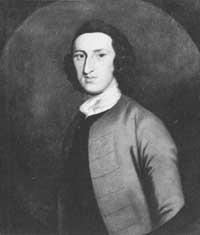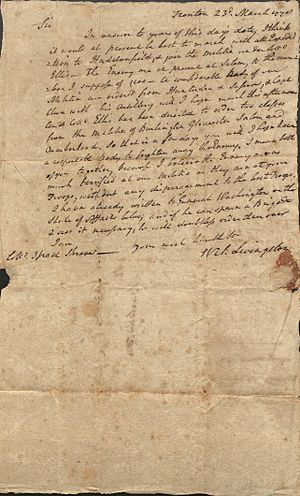William Livingston facts for kids
Quick facts for kids
William Livingston
|
|
|---|---|
 |
|
| 1st Governor of New Jersey | |
| In office August 31, 1776 – July 25, 1790 |
|
| Preceded by | William Franklin as Royal Governor |
| Succeeded by | Elisha Lawrence Acting Governor |
| Member of the New York General Assembly | |
| In office 1759–1761 |
|
| Preceded by | Robert Livingston |
| Succeeded by | Peter R. Livingston |
| Personal details | |
| Born | November 30, 1723 Albany, Province of New York, British America |
| Died | July 25, 1790 (aged 66) Elizabeth, New Jersey, U.S. |
| Resting place | Green-Wood Cemetery, Brooklyn, New York |
| Political party | Federalist |
| Spouses |
Susannah French
(m. 1745; |
| Children | 13, including Sarah, Brockholst |
| Parents | Philip Livingston Catherine Van Brugh |
| Relatives | See Livingston family |
| Alma mater | Yale College |
| Signature | |
William Livingston (born November 30, 1723 – died July 25, 1790) was an important American politician. He became the first governor of New Jersey in 1776, serving during the American Revolutionary War. He was also a representative for New Jersey in the Continental Congress. Livingston signed two very important documents: the Continental Association and the United States Constitution. Because of his contributions, he is known as one of the Founding Fathers of the United States.
Contents
Early Life and Education
William Livingston was born in Albany, which was then part of the British colony of New York. This was on November 30, 1723. His father was Philip Livingston, who was the second "Lord of Livingston Manor." This title meant his family owned a large estate. His mother was Catherine Van Brugh. William had several older siblings who also became important figures.
When he was 13, William lived for a year with Henry Barclay, an Anglican missionary. Barclay helped him prepare for college. In 1737, William enrolled at Yale College and finished his studies in 1741. After Yale, he moved to New York City. There, he began to study law, learning from famous lawyers like James Alexander and William Smith, Sr. He became a lawyer in 1748.
Starting His Career
After becoming a lawyer, Livingston started his own law practice in New York City. In 1752, he helped create a weekly newspaper called the Independent Reflector. He worked on this paper with two other lawyers, William Smith, Jr., and John Morin Scott. People at the time called them "The Triumvirate."
The Reflector was the first regular non-newspaper publication in New York. It was used by Livingston and his friends to share their political ideas. They often challenged the powerful leaders in New York City. For example, they strongly disagreed with the founding of King's College (now Columbia University). They worried it would give too much power to the Anglican Church in America.
Even though the Reflector stopped publishing in 1753 due to political pressure, Livingston kept fighting against King's College. He even managed to get half the money raised for the college to be used for a new jail instead. Despite his efforts, King's College opened in 1754.
Livingston stayed active in politics. He was elected to the American Philosophical Society in 1768. He also served one term in the New York General Assembly, which was like the state's law-making body.
Moving to New Jersey
In 1772, William Livingston moved to Elizabethtown, which is now called Elizabeth, New Jersey. He rented a house there. A young Alexander Hamilton, who would later become a Founding Father, even lived with Livingston for a time while attending school. Livingston also started building a large home for his family, which he called Liberty Hall. This house is still standing today.
Livingston became very influential among the local patriots in New Jersey. These were people who supported American independence from Britain. Because of his influence, he was chosen as one of New Jersey's representatives to the Continental Congress. He served in this important role from July 1774 to June 1776.
Governor of New Jersey During the Revolution
New Jersey's leaders did not reappoint Livingston to the Continental Congress because he was not yet fully in favor of independence. Instead, they offered him command of the state's militia, which is a group of citizen soldiers. He turned down this offer. However, he did serve as a brigadier general in the New Jersey Militia.
In August 1776, a very important event happened: William Livingston was elected the first Governor of New Jersey. This was during the height of the American Revolutionary War. For much of the war, between 1776 and 1779, his family moved to Parsippany for safety. This was because his home, Liberty Hall, was often targeted by British troops. They wanted to capture Livingston, and there was a large reward for him.
One time, in 1779, Loyalists (people who supported the British) tried to kidnap him. They were given false information that he was at his second home. The attempt failed, and the Loyalists were captured. After the war, in 1779, his family returned to Liberty Hall to repair their home, which had been looted. In 1782, he was recognized for his achievements and became a fellow of the American Academy of Arts and Sciences.
Later Years and Legacy
In 1787, Livingston joined the New Jersey group at the Constitutional Convention in Philadelphia. This was where the U.S. Constitution was written. He was one of the people who signed this incredibly important document.
In 1788, the U.S. Congress offered him a job as the United States Minister to the Netherlands, but he chose not to take it. He continued to be reelected as governor of New Jersey every year until he passed away in 1790.
William Livingston died on July 25, 1790, in Elizabeth, New Jersey. He was first buried in New York City, but later his remains were moved to Green-Wood Cemetery in Brooklyn.
Livingston wrote a long poem in 1747 called "Philosophic Solitude, or the Choice of a Rural Life." It was one of the first successful poems written by an American colonist. He also helped found the New York Society Library in 1754, which is still around today.
Several places are named in his honor, including the township of Livingston, New Jersey, Governor Livingston High School in Berkeley Heights, New Jersey, and the Livingston campus of Rutgers University.
Family Life
William Livingston married Susannah French in New Jersey in 1745. She was the daughter of a wealthy landowner. Her grandfather, Phillip French, had been the 27th mayor of New York City. William and Susannah had 13 children together.
Some of their children included:
- Susannah Livingston (1748–1840), who married John Cleves Symmes. She later became the stepmother-in-law of President William Henry Harrison.
- Sarah Van Brugh Livingston (1756–1802), who married John Jay.
- Henry Brockholst Livingston (1757–1823), who became an Associate Justice of the Supreme Court of the United States.
Notable Descendants
William Livingston's daughter, Sarah, was very well-educated for her time. She learned penmanship, English grammar, and classic literature at home. She was also taught to be aware of politics and sometimes even helped her father as his secretary.
When Sarah was 17, she married John Jay. Sarah traveled with her husband to Spain and Paris. In Paris, John Jay, along with John Adams, Benjamin Franklin, and Henry Laurens, negotiated the Treaty of Paris in 1783. This treaty officially ended the American Revolutionary War. Sarah is even said to have written the toast for the celebratory dinner after the treaty was signed.
When Sarah and John returned to New York, John Jay became the first U.S. Foreign Secretary. Sarah's experience in Paris helped her and her husband start the tradition of weekly dinners for diplomats and other guests in New York, which was then the U.S. capital. Sarah also served as the wife of the first Chief Justice of the United States and as the First Lady of New York.
Many other important people were descendants of William Livingston. These include Julia Kean, who was the wife of United States Secretary of State and New York Governor Hamilton Fish. Another descendant was Thomas Kean, who became the 48th Governor of New Jersey.
Images for kids
See also
 In Spanish: William Livingston para niños
In Spanish: William Livingston para niños



